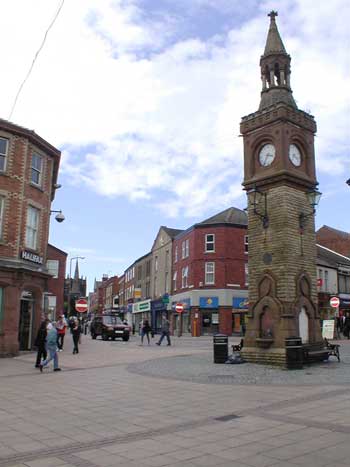
IHBC
June 2002
Issue
3
Inside: Sheila Stones Leaves North West

HELP FOR LIVERPOOLS HERITAGE
English Heritage, Liverpool City Council and other bodies
have come together to launch the Historic Environment of Liverpool Project
(HELP), to give the public an opportunity to tell developers how they see the
future of their city.
The project
aims to increase understanding of the city’s heritage, in a bid to avoid the
mistakes that have characterised the redevelopment of other cities.
A preliminary
poll of residents, carried out by MORI in February, showed great enthusiasm for
the historic environment and public attitudes will be constantly monitored
during the project.
·
The number of boarded up and disused
buildings in the city.
·
Insufficient funds to save the city’s
built heritage and
·
A lack of knowledge about the value of
the city’s historic environment.
The project
follows the Stop the Rot Campaign that featured in the evening paper the
Liverpool Echo.
The city
centre and suburbs will be the subject of a heritage mapping exercise and the
project will see development of a buildings at risk strategy for the city.
The City
Council and English Heritage will be jointly funding a conservation officer
post during the life of the project.
PH
This is the
first
Immediate
issues are, replacing Sheila as branch chair and national committee member.
But, in the longer term, Sheila’s departure provides an opportunity to consider
how members see the branch developing and what we expect of the branch chair.
Do we want a leader? Or do we want somebody to simply chair the branch
meetings, with the branch committee or membership as a whole making decisions?
As our membership is so like minded, is it important anyway?
Members should
give these matters some thought, and make every effort to attend the branch
The views expressed by contributors do not
necessarily represent those of the
Sheila Takes A Bow

Sheila announced her move, at the March
meeting of the IHBC branch committee, and advised that, as a result, she would
need to resign as national branch representative, branch chair and branch
committee member. Sheila said that she would be happy to resign with immediate
effect or at the
AB
Greater
Greater Manchester Conservation Officers Group are
nearing completion of their Manual of Conservation Techniques. The IHBC NW
Branch have agreed to act as sponsors, giving it their approval, although not
providing financial support. Publication is expected later this year.
PH
Historic
Landscape Characterisation
County archaeologists are currently being sponsored, by English Heritage, to define the character of the regions rural areas.
The research aims to identify and interpret
various types of landscape, such as pre enclosure agriculture, by looking at
the effects of human activity on the physical landscape.
The information gained will be used to help
interpret information contained on sites and monuments records, as well as
providing informed advice for development control purposes and projects such as
Countryside Stewardship.
It is envisaged that the character
appraisals will ultimately become supplementary planning guidance and will be
used to review the quality of existing designations such as areas of special
county value, feeding into new landscape strategies.
Lancashire’s countryside has already been
characterised while
PH

However the integrity of the Kathmandu
Valley World Heritage Site is under continuing threat from intense development
pressure. There has been substantial
demolition of historic buildings in and around the monument zones. Lack of public and private resources for
conservation coupled with ineffective development control by local authorities
in the face of rapid population growth and
the resultant needs for new housing have led
UNESCO to consider placing the site on its World Heritage ‘in danger’ list.
Under particular threat is the traditional
housing stock which typically consists of three or four storey structures
constructed of local fired or sun-dried brick, hardwood and small ‘jhingati’
clay roof tiles. Most date from the 17th
– 19th centuries and are particularly notable for the astonishing levels
of craftsmanship displayed in carved timber
architectural details : especially window and door apertures,
projecting second floor balconies and struts
supporting overhanging eaves. Most
houses suffer from poor maintenance and there are high levels of long-term
disrepair throughout the monument zones.
Modern, cheaper methods of building construction, often in the form of
tall concrete framed houses, are becoming an increasingly common sight in the
historic core areas and are evidence of a culture of non-compliance with local
building and planning by-laws.
Local authorities have recently acquired
extensive devolved powers but have little experience in the positive management
of historic assets, the promotion of heritage-based development initiatives,
and working in partnership with local communities. It is now recognised that a key first step
will be to find effective ways of protecting and promoting a better public
understanding of its unique historic and cultural assets – not just the
principal palaces and temples but also their wider urban settings.
Chester City Council is working
in partnership with two Nepalese local authorities – Lalitpur Sub-Metropolitan
Authority and Khokana Village Development Committee – to help in the
development of professional staff skills and the implementation of an effective
conservation strategy that will combine protection of the site with sustainable
development initiatives.
Funding has been provided by the European
Commission under its Asia Urbs programme - a cultural programme supported by
the Commission’s development and economic funds which is designed to promote
closer links between local governments in Europe and
A draft plan and budget proposal was
prepared by the partners in conjunction with UNESCO World Heritage Centre for
the development of a two year sustainable conservation and training
programme. A second European local
authority – Feltre, from the
The principal activities contained in the
project are :
·
institutional development to increase the capacity of the
Nepalese local authorities to manage the urban environment – a local project
team has now been established in Lalitpur consisting of conservation officers,
architects, archaeologists and tourism officers.

·
provision
of international experience in
issues of urban management for political leaders, project partners and key
officers – a week long seminar is to be held in
·
provision
of training and capacity building
for officers – members of the project team will work within the European local
authority conservation, archaeology and tourism teams. European professionals
will also visit
·
building and archaeological
recording with a
view to developing better systems of recognising and protecting key buildings
and areas
·
community based sustainable
development initiatives,
including the establishment of community offices to provide local people with
information and advice on traditional building repair and promote a wider
understanding of the value of protecting the cultural heritage
·
promotion
of pilot regeneration projects,
including the conversion of traditional buildings to provide high quality
tourist accommodation and improvements to the traditional urban water supply
·
development
and dissemination of information on seismic
strengthening – the last major earthquake in the
The project commenced in February 2002 and
will continue for two years. Of course
until a greater degree of political stability is achieved and there is a
revival in tourism, it will be extremely difficult to measure the full impact
of the project. Nevertheless in the
short term it will unquestionably offer an opportunity for local authorities
and communities in both Lalitpur and Khokana to work more closely together to
develop a shared vision for the future and a better understanding of the
potential for sustainable development within their historic urban core areas.
Further progress will be reported in future
editions of this newsletter.
The Extensive Urban Survey:

Lesley Mitchell has recently been appointed as project officer
for the Extensive Urban Survey for
The Lancashire Extensive Urban Survey (EUS)
is an assessment of selected towns within post-1974
An
initial study undertaken was by Lancaster University Archaeological Unit in
1997-98 when a total of 57 settlements were examined. Of these, 29 were defined
as having significant urban archaeological value and historic characteristics,
and it is these towns that are now being studied (see diagram).
The EUS is being carried out over a period
of two years by Lancashire County Council and the Egerton Lea Consultancy, with
the support of English Heritage. The study proper began in July 2001, the work
being done in three overlapping phases, comprising i) data gathering, ii)
assessment and iii) strategy.
Although EH set in motion a programme of
Extensive Urban Surveys in the early 1990s, the Lancashire EUS differs from the
‘traditional’ types of survey. The main difference is the stage of
characterisation which is being introduced.
Background
The importance of historical features within
urban areas, and particularly their contribution to heritage-led regeneration,
is becoming increasingly important. If such features are to be protected or
re-used in the best possible way, it is vital that we take stock of the
remaining historic features, so that those that contribute most, to the
character of a town, can be protected from destruction or unsuitable
development.
This EUS is particularly timely, given that
a number of factors are increasing pressures for change on the historic fabric
of

Change over time is
inevitable, but it is important that factors which contribute most to the
unique character of
The EUS involves an assessment report for
each of the towns featured. As part of these reports each town is divided into
historic plan components, which include character types such as hospitals,
public or private landscaped grounds, textile- and non-textile-based industrial
areas, 19th century grid-iron terraces, handloom weavers’
settlements and railways.
This initial work is then taken a step
further in the characterisation stage, which defines and describes the
character attributes possessed by the historic plan components. Examples of the
recorded attributes include:
·
building
materials
·
building
function
·
building
form
·
date
·
method
of accessing rear yards (for 19th century terraces)
·
areas
of cobbled surfacing
·
presence
of old-style street furniture.
The characterisation will extend beyond the
identified historic plan components to cover the whole of the remainder of the
study area, although in a less detailed way. This will involve the broad
characterisation of 20th century housing developments, as well as
the identification of areas such as schools, recreation grounds and modern
industrial sites.
Assessment and
Strategy
Once the data gathering and characterisation
processes for a particular town are complete, each character area is assessed
according to its rarity, completeness, condition and forces for change. This
assessment is used in the formulation of appropriate strategies for management
of each area. Both below-ground archaeology and above-ground historic and
archaeological fabric will be taken into consideration in the resultant
strategy documents.
The main outputs of the Lancs EUS will
include:
·
the
production of a series of Historic Environment Guidance Strategy Reports for
Local Planning Authorities;
·
the
identification of zones that merit special management policies, (hopefully to
be adopted as
·
the
creation of new records for inclusion within the SMR, which will increase
awareness of the locations and importance of sites.
Although provision will still be made
for individual sites of particular
importance, it is to be hoped that the Historic Environment Guidance Strategy
Reports will result in a change in the way urban fabric is perceived. Rather
than comprising a series of disconnected sites, towns could more usefully be
viewed as continuous landscapes made up of historic and more recent plan
components which each have a defined archaeological value.
Aston
Webb Discovered in

The building in question is on
Webb is believed to have designed
the building for a drug manufacturing company, owned by family members.
Not always critically acclaimed,
Webb was nevertheless a highly successful designer of public buildings around
1900, and was responsible for major commissions such as
Although Webb worked extensively
in the provinces there are no other remaining examples of his work on
Merseyside, with the exception of minor fragments of a house in Brackenwood,
Wirral, built for the owners of the
The new Pevsner for
PH
Registered
Office: 3 Stafford Terrace Tunbridge Wells